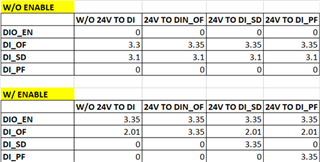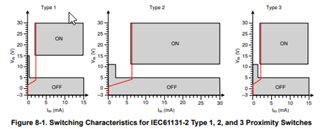Tool/software:
Hi Team,
Customer is using ISO1228DFBR for 24V Digital Input. During testing process, customer is facing below issue:
When 24V in given from J9 connector in pins 2, 3 & 4 (DIN1_OF, DIN2_SD, DIN3_PF) – Expected output of DI_OF, DI_SD, DI_PF is 3.3V.
The following data is measured before flashing the code. It is observed that when Logic is 0, DI_OF is at 2.01V instead of 0V.

After flashing the code, the DI_OF line is not receiving 3.3V, instead only 1.35-1.5V is received.
This is the case with any new board or old board.
The line of input to 24V, there’s a drop but, at least 22V is received at the input after protection. DIO_EN is directly powered by 3.3V by default.
Customer also tried to provide the first input (DIN_OF) to the 8th channel of the same IC, But no output is received on the other side.
Can you let me know, if this might be caused because of any issue with the IC?
Regards, Shinu.




